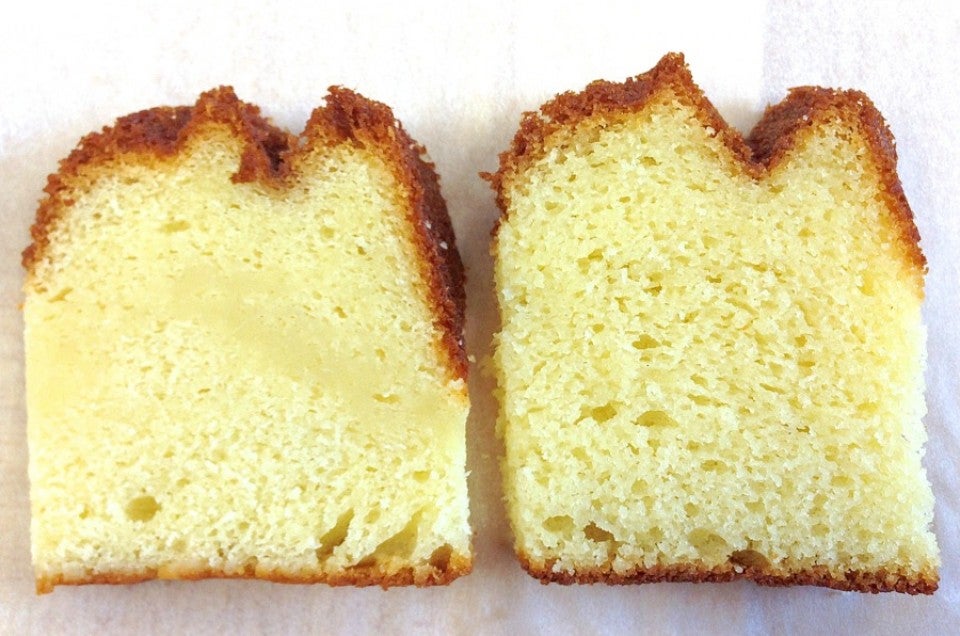


See the two slices of lemon cake above?
The one on the right has a typical texture: an even, fairly close grain.
But the one on the left shows streaks – areas of dense, sodden cake. Taking a bite, you'd think it was under-baked – even though it's actually completely baked.
One of my fellow King Arthur Flour test bakers, Frank Tegethoff, recently called me into the test kitchen for show & tell.
We bakers often do this with one another – "Hey, wanna see something interesting?" someone will say, pulling a deflated loaf of bread, ultra-flat cookie – or perfectly shaped muffin – out of the oven.
We then gather around for a quick lesson in the particular area of baking science demonstrated by said unsuccessful (or super-successful) baked good.
Frank said, "Both of these slices of cake are from the same recipe. Same ingredients; same pan. Same baking time and temperature. Why do you think this one has this pasty middle, and the other one looks fine?"
I considered the question. Preparation method must be the variable. "Ummm... something about how you put together the batter?" (The girl's a genius!)
Frank proceeded to share his secret. The cake with the pasty center was "over-creamed."
"How do you over-cream cake batter?" I asked. "I thought the more air you beat in, the better."
Frank explained that's true, but creaming (beating together sugar, butter, and eggs) has to be done slowly; "no higher than medium speed."
And once any flour is added, the mixing has to be slower still. Developing the flour's gluten too much means the cake will rise beautifully in the oven – then sink (a little, or a lot) as soon as you pull it out.
And the sinking cake is what makes dense, moist, gluey streaks.
Lesson learned: beat butter and sugar and eggs at medium speed. Once you add flour, mix gently.
Thanks, Frank!
Since you can't be right here in the test kitchen with us, we offer you the next best thing: our toll-free baker's hotline, staffed by test kitchen bakers. Next time your cake collapses, your cookies crumble, or your bread behaves badly, call us: 855-371-BAKE (2253). We're here to help.
By the way, since I know you'll ask – that's Lemon Bliss Cake Frank used in his experiment.


April 16, 2019 at 11:04am
In reply to This sometimes happen to me. My recipe requires the eggs to be … by Sofia (not verified)
March 24, 2019 at 2:13pm
March 21, 2019 at 9:38am
March 9, 2019 at 8:10pm
March 10, 2019 at 10:21am
In reply to You should have an emergency text message 💬 I am definitely goi… by Jane Lilly (not verified)
March 6, 2019 at 7:40am
March 6, 2019 at 9:44am
In reply to Hi this is the recipe i followed. But regardless of the recipe … by Sherill George (not verified)
While our team is always happy to make specific recommendations regarding our recipes and straightforward substitutions, recipes and adjustments that fall outside the scope of minor changes often require research and hands-on testing to analyze. Though we’re simply not equipped to offer that service to our customers at this time, we hope you’ll feel empowered to continue researching and putting your baking ideas to the test!
If you'd like to speak with one of our bakers and describe the pastry-like/soggy texture you've been experiencing, we're happy to have a conversation with you at 855-371-BAKE (2253). Kindly, Annabelle@KAF
March 2, 2019 at 10:55pm
March 4, 2019 at 11:07am
In reply to I made a pound cake and yet again it has the line of dense, sog… by Trish (not verified)
February 20, 2019 at 3:29pm
Pagination